+ Open data
Open data
- Basic information
Basic information
| Entry | Database: PDB / ID: 6s7p | ||||||
|---|---|---|---|---|---|---|---|
| Title | Nucleotide bound ABCB4 | ||||||
 Components Components | Phosphatidylcholine translocator ABCB4 | ||||||
 Keywords Keywords | TRANSPORT PROTEIN / ABC Transporter / Lipid extruder | ||||||
| Function / homology |  Function and homology information Function and homology informationresponse to fenofibrate / Defective ABCB4 causes PFIC3, ICP3 and GBD1 / positive regulation of phospholipid transport / positive regulation of phospholipid translocation / bile acid secretion / phospholipid transporter activity / cellular response to bile acid / phosphatidylcholine floppase activity / intercellular canaliculus / P-type phospholipid transporter ...response to fenofibrate / Defective ABCB4 causes PFIC3, ICP3 and GBD1 / positive regulation of phospholipid transport / positive regulation of phospholipid translocation / bile acid secretion / phospholipid transporter activity / cellular response to bile acid / phosphatidylcholine floppase activity / intercellular canaliculus / P-type phospholipid transporter / positive regulation of cholesterol transport / phospholipid translocation / clathrin-coated vesicle / lipid homeostasis / ATPase-coupled transmembrane transporter activity / ABC-type transporter activity / ABC-family proteins mediated transport / PPARA activates gene expression / lipid metabolic process / transmembrane transport / membrane raft / apical plasma membrane / focal adhesion / ATP hydrolysis activity / extracellular exosome / nucleoplasm / ATP binding / membrane / plasma membrane / cytosol / cytoplasm Similarity search - Function | ||||||
| Biological species |  Homo sapiens (human) Homo sapiens (human) | ||||||
| Method | ELECTRON MICROSCOPY / single particle reconstruction / cryo EM / Resolution: 3.2 Å | ||||||
 Authors Authors | Olsen, J.A. / Alam, A. / Kowal, J. / Stieger, B. / Locher, K.P. | ||||||
| Funding support |  Denmark, 1items Denmark, 1items
| ||||||
 Citation Citation |  Journal: Nat Struct Mol Biol / Year: 2020 Journal: Nat Struct Mol Biol / Year: 2020Title: Structure of the human lipid exporter ABCB4 in a lipid environment. Authors: Jeppe A Olsen / Amer Alam / Julia Kowal / Bruno Stieger / Kaspar P Locher /   Abstract: ABCB4 is an ATP-binding cassette transporter that extrudes phosphatidylcholine into the bile canaliculi of the liver. Its dysfunction or inhibition by drugs can cause severe, chronic liver disease or ...ABCB4 is an ATP-binding cassette transporter that extrudes phosphatidylcholine into the bile canaliculi of the liver. Its dysfunction or inhibition by drugs can cause severe, chronic liver disease or drug-induced liver injury. We determined the cryo-EM structure of nanodisc-reconstituted human ABCB4 trapped in an ATP-bound state at a resolution of 3.2 Å. The nucleotide binding domains form a closed conformation containing two bound ATP molecules, but only one of the ATPase sites contains bound Mg. The transmembrane domains adopt a collapsed conformation at the level of the lipid bilayer, but we observed a large, hydrophilic and fully occluded cavity at the level of the cytoplasmic membrane boundary, with no ligand bound. This indicates a state following substrate release but prior to ATP hydrolysis. Our results rationalize disease-causing mutations in human ABCB4 and suggest an 'alternating access' mechanism of lipid extrusion, distinct from the 'credit card swipe' model of other lipid transporters. | ||||||
| History |
|
- Structure visualization
Structure visualization
| Movie |
 Movie viewer Movie viewer |
|---|---|
| Structure viewer | Molecule:  Molmil Molmil Jmol/JSmol Jmol/JSmol |
- Downloads & links
Downloads & links
- Download
Download
| PDBx/mmCIF format |  6s7p.cif.gz 6s7p.cif.gz | 214.2 KB | Display |  PDBx/mmCIF format PDBx/mmCIF format |
|---|---|---|---|---|
| PDB format |  pdb6s7p.ent.gz pdb6s7p.ent.gz | 167.6 KB | Display |  PDB format PDB format |
| PDBx/mmJSON format |  6s7p.json.gz 6s7p.json.gz | Tree view |  PDBx/mmJSON format PDBx/mmJSON format | |
| Others |  Other downloads Other downloads |
-Validation report
| Summary document |  6s7p_validation.pdf.gz 6s7p_validation.pdf.gz | 1.4 MB | Display |  wwPDB validaton report wwPDB validaton report |
|---|---|---|---|---|
| Full document |  6s7p_full_validation.pdf.gz 6s7p_full_validation.pdf.gz | 1.5 MB | Display | |
| Data in XML |  6s7p_validation.xml.gz 6s7p_validation.xml.gz | 41.5 KB | Display | |
| Data in CIF |  6s7p_validation.cif.gz 6s7p_validation.cif.gz | 62.7 KB | Display | |
| Arichive directory |  https://data.pdbj.org/pub/pdb/validation_reports/s7/6s7p https://data.pdbj.org/pub/pdb/validation_reports/s7/6s7p ftp://data.pdbj.org/pub/pdb/validation_reports/s7/6s7p ftp://data.pdbj.org/pub/pdb/validation_reports/s7/6s7p | HTTPS FTP |
-Related structure data
| Related structure data |  10111MC M: map data used to model this data C: citing same article ( |
|---|---|
| Similar structure data |
- Links
Links
- Assembly
Assembly
| Deposited unit | 
|
|---|---|
| 1 |
|
- Components
Components
| #1: Protein | Mass: 140833.406 Da / Num. of mol.: 1 / Mutation: E558Q, E1200Q Source method: isolated from a genetically manipulated source Source: (gene. exp.)  Homo sapiens (human) / Gene: ABCB4, MDR3, PGY3 / Cell line (production host): Flp-In T-Rex 293 / Production host: Homo sapiens (human) / Gene: ABCB4, MDR3, PGY3 / Cell line (production host): Flp-In T-Rex 293 / Production host:  Homo sapiens (human) Homo sapiens (human)References: UniProt: P21439, P-type phospholipid transporter | ||||||
|---|---|---|---|---|---|---|---|
| #2: Chemical | | #3: Chemical | ChemComp-MG / | #4: Chemical | ChemComp-CLR / Has ligand of interest | Y | |
-Experimental details
-Experiment
| Experiment | Method: ELECTRON MICROSCOPY |
|---|---|
| EM experiment | Aggregation state: PARTICLE / 3D reconstruction method: single particle reconstruction |
- Sample preparation
Sample preparation
| Component | Name: Nucleotide Bound ABCB4 / Type: COMPLEX / Entity ID: #1 / Source: RECOMBINANT | |||||||||||||||||||||||||
|---|---|---|---|---|---|---|---|---|---|---|---|---|---|---|---|---|---|---|---|---|---|---|---|---|---|---|
| Molecular weight | Value: 0.141 MDa / Experimental value: NO | |||||||||||||||||||||||||
| Source (natural) | Organism:  Homo sapiens (human) Homo sapiens (human) | |||||||||||||||||||||||||
| Source (recombinant) | Organism:  Homo sapiens (human) / Cell: Flp-In T-Rex 293 Homo sapiens (human) / Cell: Flp-In T-Rex 293 | |||||||||||||||||||||||||
| Buffer solution | pH: 7.5 | |||||||||||||||||||||||||
| Buffer component |
| |||||||||||||||||||||||||
| Specimen | Conc.: 0.5 mg/ml / Embedding applied: NO / Shadowing applied: NO / Staining applied: NO / Vitrification applied: YES / Details: 5mM Magnesium Chloride 5mM ATP | |||||||||||||||||||||||||
| Specimen support | Grid material: COPPER / Grid mesh size: 300 divisions/in. / Grid type: Quantifoil R1.2/1.3 | |||||||||||||||||||||||||
| Vitrification | Instrument: FEI VITROBOT MARK IV / Cryogen name: ETHANE-PROPANE / Humidity: 100 % / Chamber temperature: 277.15 K |
- Electron microscopy imaging
Electron microscopy imaging
| Experimental equipment |  Model: Titan Krios / Image courtesy: FEI Company |
|---|---|
| Microscopy | Model: FEI TITAN KRIOS |
| Electron gun | Electron source:  FIELD EMISSION GUN / Accelerating voltage: 300 kV / Illumination mode: FLOOD BEAM FIELD EMISSION GUN / Accelerating voltage: 300 kV / Illumination mode: FLOOD BEAM |
| Electron lens | Mode: BRIGHT FIELD |
| Image recording | Electron dose: 68 e/Å2 / Detector mode: SUPER-RESOLUTION / Film or detector model: GATAN K2 SUMMIT (4k x 4k) |
| Image scans | Movie frames/image: 40 |
- Processing
Processing
| EM software |
| ||||||||||||||||
|---|---|---|---|---|---|---|---|---|---|---|---|---|---|---|---|---|---|
| CTF correction | Type: PHASE FLIPPING AND AMPLITUDE CORRECTION | ||||||||||||||||
| Symmetry | Point symmetry: C1 (asymmetric) | ||||||||||||||||
| 3D reconstruction | Resolution: 3.2 Å / Resolution method: FSC 0.143 CUT-OFF / Num. of particles: 193929 / Symmetry type: POINT |
 Movie
Movie Controller
Controller





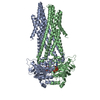
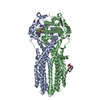
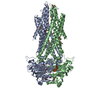
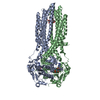

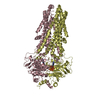
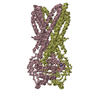
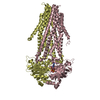
 PDBj
PDBj













